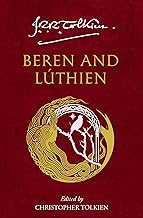
Review: Beren and Lúthien – A Passage Extracted from the Quenta
評論:貝倫與露西恩《諾多族的歷史》選段一
Introduction
The tale of Beren and Lúthien is one of the most central and poignant legends in J.R.R. Tolkien’s legendarium. It transcends the boundaries between Elves and Men, life and death, fate and free will. While most readers are familiar with the beautifully tragic rendition in The Silmarillion or the poetic masterpiece The Lay of Leithian, the version presented in A Passage Extracted from the Quenta (also referred to as The Quenta Noldorinwa) offers an earlier and more succinct take on the myth, embedded in the historical scaffolding of the mythology.
This passage reflects Tolkien’s shift from mythic sketch to mythic history. Though it lacks the narrative flourishes and lyricism of later iterations, it contains the essential structure of the legend and is invaluable in understanding the developmental arc of Tolkien’s storytelling.
引言
貝倫與露西恩·緹努維爾的傳說,是J.R.R.托爾金整個傳說體系中最核心、最動人心魄的神話之一。這個故事超越了精靈與人類的界線、生命與死亡的界限、命運與自由意志的衝突。雖然大多數讀者對這段傳奇的認識來自《精靈寶鑽》中那個既優美又悲壯的版本,或詩體鉅作《蕾西安之歌》的抒情敘述,但在《諾多族的歷史》選段(也稱為 The Quenta Noldorinwa)中所呈現的版本,則提供了這段神話更早期且更為簡潔的詮釋,嵌入在整體神話歷史的架構之中。
這一選段體現了托爾金從「神話草圖」邁向「神話歷史」敘事風格的轉變。儘管它缺乏後期版本的敘事華麗與抒情筆觸,卻保留了這段傳奇的基本骨架,對於理解托爾金故事講述方式的發展歷程具有不可或缺的價值。
Summary of the Passage
In this earlier prose version, the story is presented in a condensed, almost annalistic tone. The core events remain consistent with the later versions but are described more plainly:
Beren, fleeing after the destruction of his homeland by Morgoth's armies, ventures into Doriath, where he first sees Lúthien Tinúviel and is immediately captivated by her beauty.
Thingol, her father, disapproves of their union and sets an impossible condition: Beren must retrieve a Silmaril from Morgoth’s iron crown.
Beren begins his quest, eventually joined by Lúthien despite Thingol’s wishes. Her role, though vital, is described in this version with far less detail and agency than in The Lay of Leithian.
Their attempt to retrieve the Silmaril ends with Beren’s hand being bitten off by the wolf Carcharoth, and they return to Doriath with only part of the quest fulfilled.
選段概要
在這個較早期的散文版本中,整個故事以一種簡潔、幾近編年史的語調呈現。核心事件與後期版本基本一致,但描述上更為平實直接:
貝倫在家園被魔苟斯軍隊摧毀後逃亡,輾轉進入瑞亞斯,在那裡他第一次見到露西恩·緹努維爾,立刻被她的美貌深深吸引。
辛葛,露西恩·緹努維爾的父親,反對他們的結合,並提出一項幾乎不可能完成的條件:貝倫必須從魔苟斯的鐵冠上取下一顆精靈寶鑽。
貝倫因此展開了他的使命,最終儘管辛葛反對,露西恩·緹努維爾仍選擇與他一同踏上旅程。然而,在《諾多族的歷史》中的這個版本,她的角色雖然依舊關鍵,卻缺乏《蕾西安之歌》中所描繪的細節與主動性。
他們嘗試奪回精靈寶鑽的任務最終以貝倫的手被惡狼卡哈洛斯咬斷告終。他們帶著尚未完全實現的使命返回瑞亞斯。
Narrative Structure and Tone
One of the most noticeable features of this version is its tone. Unlike the emotive depth and poetic cadence of The Lay of Leithian, the Quenta passage is straightforward and concise. It prioritizes the factual progression of events over introspection or lyrical embellishment. The story reads like a historical chronicle, placing the tale within a larger mythic context rather than highlighting individual emotions or character arcs.
This structure aligns with Tolkien’s initial aim for The Quenta Noldorinwa—to serve as a "Silmarillion proper," or a historical account of the Elder Days. It allows us to see the legend of Beren and Lúthien as one thread woven into the vast tapestry of the Elder Days, rather than as a self-contained romance.
敘事結構與語調
在本版本中,最明顯的特徵之一便是其敘事語調的轉變。與《蕾西安之歌》所展現的深厚情感與詩意節奏不同,《諾多族的歷史》中的這段選文採用了更為直白且簡潔的方式來講述故事。它強調事件的事實進展,而非角色的內心描寫或抒情性的潤飾。整體故事讀來更像是一篇歷史紀錄,而非聚焦個體情感與人物弧線的浪漫傳說。
這樣的敘事結構正符合托爾金對《諾多族的歷史》最初的設定——也就是成為《精靈寶鑽》的正式版本,一部長久年代的歷史記述。透過這種呈現方式,我們得以將貝倫與露西恩·緹努維爾的傳說視為遠古紀元歷史長河中的一環,而非一段獨立自成的愛情故事。這樣的處理手法使其在神話脈絡中的地位更加突出,也揭示了托爾金如何有系統地構築他那龐大而縝密的中土世界神話體系。
Characterization of Beren and Lúthien
In this version, Beren is already cast as the mortal hero fated for suffering and glory. However, his internal struggle is minimized. He is defined more by his deeds than his emotions.
Lúthien’s portrayal is even more reduced. While she still defies her father and joins Beren, her resourcefulness, magical prowess, and resilience—so memorably displayed in The Lay of Leithian—are largely glossed over. Her transformation into a bat, her enchanting of Morgoth, and her role in Beren’s survival are either absent or only briefly mentioned. She appears more as a noble elven maiden accompanying her lover than the full-fledged heroine she would become.
貝倫與露西恩·緹努維爾的人物描寫
在《諾多族的歷史》的這個版本中,貝倫已被塑造成那位註定要歷經苦難與榮耀的凡人英雄。然而,他內在的掙扎卻幾乎未被描寫。他的性格更多是透過行動來呈現,而非透過情感層面來建構。
露西恩·緹努維爾的描寫則更加簡化。雖然她依然違抗辛葛的意志並選擇與貝倫同行,她的機智、魔法天賦與堅韌精神——這些在《蕾西安之歌》中令人難以忘懷的特質——在此版本中幾乎被一筆帶過。她變身為蝙蝠、施法迷惑魔苟斯、以及在拯救貝倫過程中所發揮的關鍵作用,不是完全缺席,就是僅略作提及。她的角色更像是一位高貴的精靈少女,單純陪伴著她所愛的凡人,而不是那位獨當一面、令人敬仰的真正女英雄。
Themes
Love and Sacrifice
Even in its abridged form, the tale still resonates with the themes of love enduring beyond all barriers. However, the emotional impact is muted. Beren and Lúthien’s bond is depicted more as a narrative inevitability than a deeply personal connection forged through shared trials.
Fate and Doom
The passage strongly echoes the fatalistic tone found in Norse sagas. Doom is an ever-present force. Beren’s destiny is one of suffering, and though Lúthien joins him, she does not alter his fate—only delays it. Unlike later versions, where love becomes a redemptive power that challenges fate, this account adheres more strictly to the path laid out by prophecy.
Mortality and Immortality
This version already contains the seeds of Tolkien’s exploration of the Gift of Men and the burden of Elven immortality. However, these existential questions remain in the background, awaiting fuller exploration in The Silmarillion and The Lay of Leithian.
主題探討
愛與犧牲
即使在這個簡化版本中,這個故事仍然回響著「愛超越一切障礙」的主題。然而,情感的衝擊力在此版本中顯得較為薄弱。貝倫與露西恩·緹努維爾之間的羈絆,被呈現為敘事上不可避免的進展,而非透過共同歷經磨難所建立的深厚情感。
命運與厄運
這段敘述強烈呼應了北歐史詩中常見的宿命主義色彩。厄運是始終存在的力量。貝倫的命運註定是苦難,即便露西恩·緹努維爾加入他的旅程,她也無法真正改變他的命運——僅僅是延遲它的發生。與後期版本相比(例如《蕾西安之歌》與《精靈寶鑽》),愛情在這裡並未成為挑戰命運、帶來救贖的力量,而是更嚴格地遵循了預言所鋪設的命途。
凡人與永生
此版本已經包含了托爾金對「人類的贈禮」——即死亡——以及精靈永生負擔的初步探討。儘管如此,這些存在層次的哲學問題在《諾多族的歷史》中仍屬於潛藏背景的議題,尚待《蕾西安之歌》與《精靈寶鑽》中更完整地揭示與深化。
Literary and Mythological Context
Tolkien was still experimenting with tone, scope, and character when he wrote this version. It serves as a bridge between the Sketch of the Mythology and the more elaborate forms in The Silmarillion and The History of Middle-earth volumes. It shows Tolkien gradually moving from a world of loosely connected tales to a cohesive mythology with recurring themes and genealogies.
Moreover, this passage reveals the central myth-making function of Beren and Lúthien’s tale. It sets the stage for later romances—Aragorn and Arwen being the most notable parallel in The Lord of the Rings. It also foreshadows the mingling of Elven and Mortal bloodlines, culminating in Elrond and Elros, and through them, the fates of Rivendell and Númenor.
文學與神話脈絡
當托爾金撰寫此版本時,他仍處於對語調、敘事範圍與角色塑造進行實驗與摸索的階段。這段文本可被視為介於《神話草圖》與《精靈寶鑽》及《中洲歷史》系列更精緻形式之間的過渡之作。它展現了托爾金如何逐步從一系列彼此鬆散連結的故事,發展成一套結構緊密的神話體系,蘊含反覆出現的主題與世系淵源。
此外,此段落也揭示了貝倫與露西恩·緹努維爾的故事在托爾金神話創作中的核心功能。這段愛情傳說奠定了日後其他浪漫故事的基礎——最顯著的例子即是《魔戒》中亞拉岡與亞玟的戀情。它同時也預示了精靈與人類血脈的融合,這最終造就了愛隆與愛洛斯的誕生,而透過這對兄弟的選擇,決定了瑞文戴爾與努門諾爾兩個世界的命運。
Final Thoughts
The passage of Beren and Lúthien from The Quenta Noldorinwa may appear simple compared to the majestic forms that followed, but it is of immense value to anyone seeking to understand the evolution of Tolkien’s mythology. It captures the skeleton of one of Middle-earth’s most important legends, allowing readers to trace how a chronicle of deeds grew into a love story of mythic proportions.
For scholars, fans, and writers alike, this version offers a glimpse into Tolkien’s mythopoeic process—his transformation of a personal story, inspired by his wife Edith, into a legend that would echo through the Ages of Arda.
最後的思考
出自《諾多族的歷史》的〈貝倫與露西恩〉選段,或許在形式上顯得簡單,無法與後來那幾個宏偉的版本相提並論,但對於任何試圖理解托爾金神話發展過程的讀者而言,它都具有無比珍貴的價值。這段文字保留了中土世界最重要傳說之一的骨架,讓讀者得以追溯,一段簡要的英雄事蹟紀錄如何逐漸蛻變為一則擁有神話規模的愛情故事。
無論是學者、書迷,還是寫作者,此版本都提供了一扇窗,讓人窺見托爾金的造神過程(mythopoeic process)——他如何將一段受妻子伊迪絲啟發的私人情感故事,轉化為一則橫跨整個亞爾達紀元的永恆傳奇。
- 點擊數: 53
電影
動作
冒險
動畫
喜劇
犯罪
記錄
戲劇
家庭
奇幻/科幻
電視
動作
冒險
動畫
喜劇
犯罪
記錄
戲劇
家庭
奇幻/科幻
歷史
阿拉巴馬州
旅遊
阿拉巴馬州





































































































